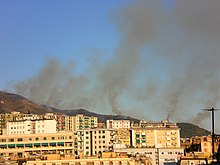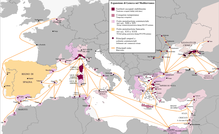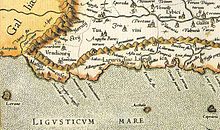Liguria
![]()
Liguria is a redirect to this article. For the asteroid of the same name see (356) Liguria.
Liguria (Italian: Liguria) is a coastal region in northwestern Italy with a population of 1,543,127 as of 31 December 2019, and is the third smallest Italian region by area. Liguria borders France to the west, the Piedmont region to the north, Emilia-Romagna and Tuscany to the east, and the Ligurian Sea, part of the Mediterranean Sea, to the south. The region is part of the transnational Euroregion Alpi-Mediterraneo/Alpes-Méditerranée.
Bordered by the mountain ranges of the Alps and the Apennines in the northeast, the Ligurian region is traditionally divided into the Riviera di Ponente and the Riviera di Levante. The border point is the regional capital Genoa.
Already in the Roman Empire it was called Liguria. In the Middle Ages, Liguria was divided into several city-states - the best known being the Republic of Genoa, which from the late 14th century was able to absorb the whole of what is now the region. From 1797-1815 the area belonged to France, then to Sardinia-Piedmont, which in 1861 was absorbed into the newly formed Kingdom of Italy. Today, Liguria is known for its tourism (thanks to the Italian Riviera), its olive oil (from the Taggiasca olive) and its wine. The "Pesto alla genovese" as well as the ravioli are well-known representatives of the Ligurian cuisine.
The capital of Liguria is Genoa. Other well-known cities are Sanremo, La Spezia, Ventimiglia (terminus of many trains from France), Alassio, Imperia (production of olive oil), Rapallo, Portofino and Savona.
Geography
Main article: Geography of Liguria
The region has an area of 5,410 km² and a population of 1.6 million. It stretches along the coast of the Ligurian Sea. To the north, it is protected by two mountain ridges that reach the sea: the Ligurian Alps, sometimes called Alpi Marittime, which extend from Monte Saccarello, the highest mountain in Liguria at 2201 m, to Colle di Cadibona, and the Appennino Ligure ("Ligurian" or "Northern Apennines"), which adjoins to the east and separates the Ligurian coast from the Po Valley to the northeast.
Liguria is divided into three provinces and one metropolitan city: (from west to east) Imperia, Savona, Genoa (metropolitan city) and La Spezia. The coastline, over 300 kilometres long, is divided into the Riviera di Ponente ("setting sun"; western part between Genoa and the French border) and the Riviera di Levante ("rising sun"; eastern part from Genoa to La Spezia). The Riviera di Ponente is in turn divided into the Riviera of Flowers (Riviera dei Fiori - from Ventimiglia to Cervo) and the Riviera of Palms (Riviera delle Palme - from Cervo to beyond Savona).
Climate
Liguria has a Mediterranean climate, which is not uniformly distributed. The climate is influenced by the strong morphological differences of the territory. The Ligurian hinterland is dominated by the high mountain ranges, while the coastline is dominated by the relatively warm Ligurian Sea.
The arched shape of the region, open to the south, and the mountain range to the northeast, which stretches from the French border to Tuscany, are the main factors of the special Ligurian climate. The Apennines, in particular, act as a watershed between the Mediterranean Sea and the Adriatic Sea, or the Po Valley.
In winter, when an area of low pressure builds up over the Ligurian Gulf, the zone around the Ligurian capital is hit by the cool Tramontane wind, which brings rain and snowfall. Along the Genoese and Savonese coasts, snow sometimes falls even at sea level. The summer is moderately warm and humid. Thus, at Genoa Sestri in July, the average temperature reaches between +20.8 °C and +27.2 °C. As a rule, the +30 °C daytime temperature is exceeded only three to four times in the month of July, but the relative humidity remains elevated even in the afternoon hours. The heat felt as a result is alleviated only by the sea breeze.
In the inland, the climate is of the harsher semi-continental type. The average temperatures reached in winter are significantly lower than those of the coastal zones. Especially the areas facing the Po Valley are characterized by a colder climate. For example, the average daily temperature in January in Cairo Montenotte is +1.8 °C, in Sassello +1.4 °C and in Busalla +2.2 °C. The mean lows in these municipalities range between -2 °C and -4 °C. The general lowest winter temperature is given as -10 °C, although on particularly cold nights the temperature can be much lower. In summer, daytime temperatures are relatively high, but are marked by significant drops in temperature at night. For example, Cairo Montenotte, at an altitude of 338 metres, records the lowest temperature at night in summer at +15 °C and the highest temperature value in the daytime at +27.7 °C.

Bushfires near Genoa in September 2009
History
![]()
This article or section needs revision. More details should be given on the discussion page. Please help improve it, and then remove this tag.
Liguria derives its name from its pre-Roman inhabitants, the Ligurians. In the 3rd century BC, the Ligurian coast came under Roman control. Roman Liguria formed the ninth region under Augustus's administrative structure and extended far beyond the present region to include the northern slopes of the Apennines and the Maritime Alps between Trebia and the Po, and beyond Albintimilium (near modern Ventimiglia). In keeping with the mountainous and wooded landscape, there were few important towns. Dertona was the only colony, and Alba Pompeia, Augusta Bagiennorum (near Bene Vagienna), Pollentia (part of modern Bra), Hasta, Aquae Statiellae, and Genoa are still worthy of mention. The majority of the Ligurians, however, lived in villages. The division of Augustus remained until Diocletian. Then the two Alpine provinces were abolished, and the watershed became the boundary between Italy and Gaul. The name Liguria was now applied to an area that extended to Milan. In the 6th century Liguria was again separated from Milan, and under the Lombards it formed the fifth Italian province called Alpes Cottiae.
Medieval
In the Middle Ages, the part of ancient Liguria north of the Apennines fell to Piedmont and Lombardy, while the southern part with the coastal strip belonged to the Republic of Genoa. For the history in the following centuries, see History of Genoa.

Republic of Genoa

Map of ancient Liguria between the river Var and Magra
Search within the encyclopedia